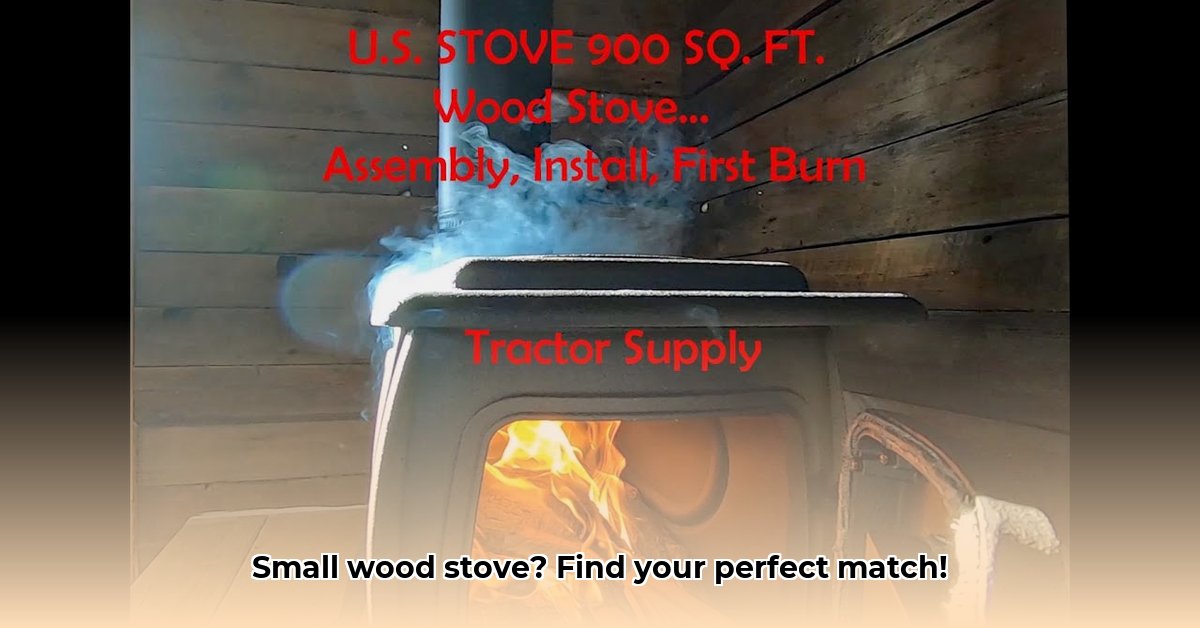
Want a cozy, warm home without the hefty heating bills? A small wood stove might be the perfect solution. This buyer's guide helps you navigate the choices at Tractor Supply, ensuring you select a safe, efficient, and budget-friendly option. We'll cover everything from BTU ratings and EPA certifications to installation and maintenance, empowering you to make an informed decision. For more detailed information on models, check out Tractor Supply's wood stove selection.
Choosing Your Perfect Small Wood Stove: Key Considerations
Before you begin shopping, understanding key factors will simplify the process. Choosing the right stove isn't just about aesthetics; it's about efficiency, safety, and value.
BTU Output and Efficiency: Understanding the Numbers
BTUs (British Thermal Units) measure a stove's heat output. Higher BTUs mean more heat. However, efficiency is equally crucial. A highly efficient stove maximizes heat from less wood, saving you money and reducing your environmental impact. Think of it as the "gas mileage" of your heating system—higher is better. A higher BTU output combined with a higher efficiency rating ensures maximum heating capacity with minimal fuel consumption.
EPA Certification: A Mark of Environmental Responsibility
An EPA-certified stove signifies it meets stringent emission standards, resulting in cleaner air for you and your community. This certification demonstrates the manufacturer's commitment to environmentally responsible heating practices. Choosing an EPA-certified stove is not just a responsible choice; it's investing in cleaner air and a healthier environment.
Stove Styles: Freestanding vs. Inserts
Consider your home layout and existing fireplace. Freestanding stoves offer placement flexibility. Inserts are designed for integration into existing fireplaces, potentially revitalizing an underutilized feature. The ideal style depends entirely on your existing space and personal preferences. Do you need a space-saving solution, or do you prefer the versatility of a freestanding unit?
Materials Matter: Cast Iron vs. Steel
Cast iron stoves are renowned for exceptional heat retention. They heat up more slowly but maintain warmth longer, delivering consistent heat. Steel stoves heat up quickly but might not hold heat as long. While both are durable, the optimal choice depends on individual heating preferences. Because detailed performance data can vary greatly between models, check Tractor Supply's website or contact their staff for specifics.
Features for Enhanced Convenience
Additional features can significantly improve your wood-burning experience. Glass doors allow you to enjoy the mesmerizing flames. A blower enhances air circulation for faster and more even heating. An efficient ash removal system simplifies cleanup. While these features often increase the cost, their value should be weighed against your budget and priorities.
Size and Heating Capacity: The Goldilocks Principle
This is critical! An undersized stove won't adequately heat your space, while an oversized stove is inefficient and potentially dangerous. Carefully assess the area you need to heat and select a stove with a corresponding BTU output. Tractor Supply staff can assist in determining the correct stove size for your needs. Don't underestimate the importance of proper sizing for efficient and safe heating.
Finding Your Perfect Tractor Supply Stove: Leveraging Available Resources
While online information is helpful, detailed specifications may be limited. Here's how to obtain the necessary information:
Directly Contact Tractor Supply: Call their customer service or visit a local store. Their staff possesses in-depth product knowledge and can answer specific questions, offer tailored recommendations, and facilitate comparisons. This personal interaction is invaluable in choosing the right wood stove.
Become a Website Detective: Thoroughly examine product images and descriptions on the Tractor Supply website. Sometimes, crucial details are subtly revealed in images or within the text. Pay close attention to detail – small clues can make a big difference in your decision.
Create a Comparison Table: Once you gather information, create a comparison table to visually assess the pros and cons of each stove. Even incomplete data offers a valuable comparison framework.
(Example Comparison Table - Fill this using information from Tractor Supply's website and staff.)
| Model Name | BTU Output (approx.) | Efficiency Rating (approx.) | Key Features | Material | Price (approx.) |
|---|---|---|---|---|---|
| Model A | |||||
| Model B | |||||
| Model C |
Safety First: Operation and Maintenance
Wood stoves present inherent risks. Prioritizing safety is paramount.
Professional Installation: While some stoves seem simple to install, professional installation ensures proper ventilation and minimizes safety risks.
Proper Ventilation: Adequate ventilation prevents deadly carbon monoxide buildup. Never compromise on ventilation—it’s a critical safety measure.
Regular Chimney Cleaning: Annual (or more frequent) professional chimney cleaning prevents creosote buildup, a significant fire hazard.
Safe Fuel Storage: Store firewood in a dry, safe location away from the stove to prevent accidental fires.
Never Leave Unattended: Never leave a burning wood stove unattended.
Installation: Essential Considerations
Even with small stoves, proper installation is vital for safety and efficiency. If you lack experience, hire a qualified professional. Always adhere to local building codes and regulations. Ensure proper ventilation for safe and efficient operation.
Final Thoughts: Choosing Your Perfect Stove
Selecting a small wood stove requires careful planning. This guide empowers you to choose a suitable stove based on your needs and budget. Remember to prioritize safety, utilize all available resources, and enjoy the warmth and comfort of your new wood stove! Visit Tractor Supply to explore available options and find the perfect fit for your home.